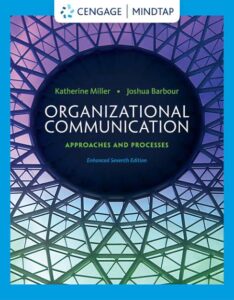Description
Test Bank For Organizational Communication Approaches and Processes Enhanced 7th Edition
CHAPTER 6
CRITICAL AND FEMINIST APPROACHES
TEST ITEMS (corresponding text page number is listed for each item)
True/False Items
F 1. Critical theorists do not consider organizations to be sites of domination. (p. 100)
T 2. Critical approaches to organizational communication have their philosophical roots in the work of Karl Marx. (p. 101)
F 3. Scholars taking a traditional approach to power believe that there are inherent contradictions between the “surface structure” of power and the “deep structure” of power. (pp. 101-102)
T 4. Ability to cope with uncertainty is a source of power in organizations. (p. 102)
F 5. The modes of production refer to actual work processes. (p. 103)
T 6. Simple control involves direct and authoritarian exertion of control in the workplace. (p. 108)
F 7. In a hegemonic relationship, the controlled group accepts, but does not actively participate in, the control process. (pp. 105-106)
T 8. The ultimate goal of the critical model is emancipation. (p. 106)
F 9. Standpoint feminists believe that remedies for female subordination should come from within the system. (p. 113)
T 10. According to Clair, frames are often used to reinforce dominant ideology. (p. 114)
T 11. Resistance considers how workers can exert counter pressure from an organization’s power and control. (p. 114)
Multiple Choice Items
1. Demetrius is a graduate student in organizational communication. After much study, he’s concluded that though there is a great deal of conflict in most organizations, the conflict is usually productive and leads to enhanced understanding and better decisions. Which frame of reference to organizational study is Demetrius adopting?
a. unitary frame of reference
b.pluralist frame of reference (*) (p. 100)
c. radical frame of reference
d. confliction frame of reference
2. In their study of the ideology of work and home life, Tracy and Rivera find male executives
a.abstractly say work life should take precedence over home life.
b.do not support the idea of gender equity in the workplace.
c.were not hesitant at all to speak about the complex relationship between work and home.
d.focused more on describing their daughters’ family lives rather than their work lives. (*) (p. 110)
3. Gail has been working as a seamstress for 20 years, but her job is soon going to be changed drastically as the plant she works in becomes automated. According to Marxist theory, Gail may become alienated when this happens because
a. management has control over the modes of production.
b.management has control over the means of production. (*) (pp. 103-104)
c. management has control over production rewards.
d. management has control over production quotas.
4. Feminists who work to enhance the opportunity for a variety of marginalized voices to be heard within societal dialogue are called
a.standpoint feminists. (*) (p. 113)
b.radical feminists.
c.liberal feminists.
d.postmodern feminists.
5. The role of the critical theorist in the emancipation process is similar to the role of a
a. mediator.
b. freedom fighter.
c. detective.
d.psychoanalyst. (*) (p. 107)
6. Susan works as a firefighter in a male-dominated organization. She is often sexually harassed on the job by her male coworkers. When asked about the appropriateness of this behavior, Susan sighs, “Boys will be boys. What can I do about it, anyway?” According to the critical approach, Susan is
a. focusing on the “good of the organization” by placing organizational needs before her own.
b.hegemonically contributing to the control of the patriarchal organizational power structure. (*) (p. 105)
c. admitting the power of the modes and mean of production.
d. emancipating others within the work environment.
7. If a researcher is interested in learning how power impacts outcomes like job satisfaction and performance, he or she is using a ________ approach.
a.radical-critical
b.hegemonic
c.traditional (*) (p. 101)
d.symbological
8. Of the three strategies used for exerting control in organizations, the one characterized by directly exerting authoritarian control is
a. technological control.
b. bureaucratic control.
c.simple control. (*) (p. 108)
d. overarching control.
9. Robin Clair’s research on sexual harassment and women’s narratives indicates that
a. women frame sexual harassment as a function of the matriarchal nature of organizations.
b.women frame sexual harassment in a way that keeps harassment out of the mainstream of organizational life. (*) (p. 114)
c. women frame sexual harassment as a political struggle that must be dealt with on a societal level.
d. women frame sexual harassment as both physical and mental oppression.
10. Paige Edley’s study of discourse at a woman-owned business found that
a. everyone in the business talked about having a cooperative and friendly workplace.
b. the owner of the business derided those who took off too much time for family
concerns.
c. the emotional nature of communication within the organization was often labeled as simply the way women talk.
d.all of the above (*) (p. 115)

Reviews
There are no reviews yet.